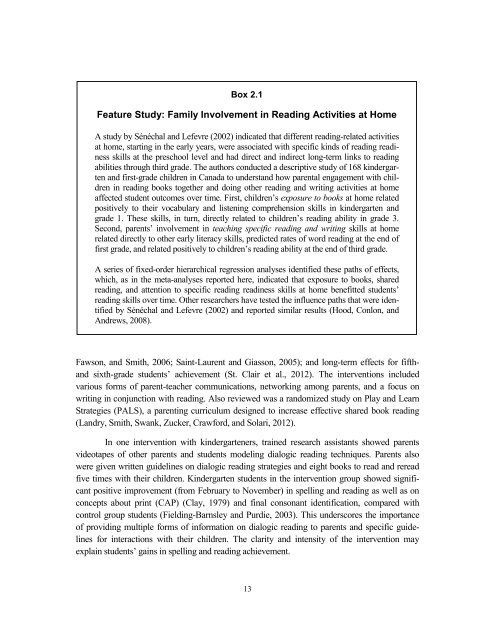u3QtN
u3QtN
u3QtN
Create successful ePaper yourself
Turn your PDF publications into a flip-book with our unique Google optimized e-Paper software.
Box 2.1<br />
Feature Study: Family Involvement in Reading Activities at Home<br />
A study by Sénéchal and Lefevre (2002) indicated that different reading-related activities<br />
at home, starting in the early years, were associated with specific kinds of reading readiness<br />
skills at the preschool level and had direct and indirect long-term links to reading<br />
abilities through third grade. The authors conducted a descriptive study of 168 kindergarten<br />
and first-grade children in Canada to understand how parental engagement with children<br />
in reading books together and doing other reading and writing activities at home<br />
affected student outcomes over time. First, children’s exposure to books at home related<br />
positively to their vocabulary and listening comprehension skills in kindergarten and<br />
grade 1. These skills, in turn, directly related to children’s reading ability in grade 3.<br />
Second, parents’ involvement in teaching specific reading and writing skills at home<br />
related directly to other early literacy skills, predicted rates of word reading at the end of<br />
first grade, and related positively to children’s reading ability at the end of third grade.<br />
A series of fixed-order hierarchical regression analyses identified these paths of effects,<br />
which, as in the meta-analyses reported here, indicated that exposure to books, shared<br />
reading, and attention to specific reading readiness skills at home benefitted students’<br />
reading skills over time. Other researchers have tested the influence paths that were identified<br />
by Sénéchal and Lefevre (2002) and reported similar results (Hood, Conlon, and<br />
Andrews, 2008).<br />
Fawson, and Smith, 2006; Saint-Laurent and Giasson, 2005); and long-term effects for fifthand<br />
sixth-grade students’ achievement (St. Clair et al., 2012). The interventions included<br />
various forms of parent-teacher communications, networking among parents, and a focus on<br />
writing in conjunction with reading. Also reviewed was a randomized study on Play and Learn<br />
Strategies (PALS), a parenting curriculum designed to increase effective shared book reading<br />
(Landry, Smith, Swank, Zucker, Crawford, and Solari, 2012).<br />
In one intervention with kindergarteners, trained research assistants showed parents<br />
videotapes of other parents and students modeling dialogic reading techniques. Parents also<br />
were given written guidelines on dialogic reading strategies and eight books to read and reread<br />
five times with their children. Kindergarten students in the intervention group showed significant<br />
positive improvement (from February to November) in spelling and reading as well as on<br />
concepts about print (CAP) (Clay, 1979) and final consonant identification, compared with<br />
control group students (Fielding-Barnsley and Purdie, 2003). This underscores the importance<br />
of providing multiple forms of information on dialogic reading to parents and specific guidelines<br />
for interactions with their children. The clarity and intensity of the intervention may<br />
explain students’ gains in spelling and reading achievement.<br />
13


